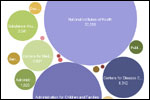By
Christopher Weaver
KFF Health News Staff Writer
FEB 02, 2010
The lion’s share – by far – of the Department of Health and Human Services’ budget is consumed by Medicare and Medicaid, the towering entitlement programs that cover health care for the elderly/disabled and low-income, respectively. Together, and with additional smaller mandatory spending programs, they make up a whopping $818 billion of the government’s $911 billion health bill for 2011.
The rest – $81.2 billion – will go to discretionary spending in President Obama’s proposal for the 2011 HHS budget. As usual, the biggest chuck will pay for research at the National Institutes of Health. (The Administration for Children and Families, which runs the welfare program Temporary Assistance for Needy Families program, also soaks up a big portion of the budget.)
Among the discretionary spenders, three agencies win bigger-than-normal increases. The Agency for Healthcare Research and Quality (AHRQ) would increase from $397 million this year to $611 million to – among other things – continue pursuing comparative effectiveness research. The administration’s top e-health official’s budget would be hoisted from $103 million this year to $156 million. And, HHS spending on curbing health care fraud will soar from $311 million to $561 million next year.
“Losers” include the Centers for Disease Control and Prevention, which face a modest cut of 1.93 percent compared with this year.
These numbers reflect budget authority, not the actual spending outlays, which may be higher. The budgets for AHRQ and the e-health do include outlays because the administration has included those amounts in its own review of agency budgets, and because AHRQ’s only funding for 2011 comes in the form of outlays. (See the Department of Health and Human Services’ budget summary.)
The president’s proposal won’t make it into law as written. He’ll send it to lawmakers to give them a starting point, but a very different plan will likely emerge from the labyrinth of Congress. KFF Health News will be tracking the changes, so check back for updates.
To view the interactive graphic, click on the link that says “Click To Interact.” (Please note: you may need to download Sun’s Java Plugin to see the visualizations.)
http://manyeyes.alphaworks.ibm.com/manyeyes/visualizations/c068b3ee100711df80a7000255111976/comments/c06bb4fe100711df80a7000255111976.js
(Graphic: Beth Liu, KFF Health News)
Data Set:
| Agency/Program | 2011 (in millions) |
2010 (in millions) |
| National Institutes of Health | 32,089 | 31,089 |
| Administration for Children and Families | 17,480 | 17,336 |
| Health Resources and Services Administration | 7,511 | 7483 |
| Centers for Disease Control and Prevention | 6,342 | 6,467 |
| Indian Health Service | 4,406 | 4,052 |
| Centers for Medicare & Medicaid Services (CMS) | 3,601 | 3,415 |
| Substance Abuse and Mental Health Services Administration | 3,541 | 3,432 |
| Food and Drug Administration | 2,508 | 2,362 |
| Administration on Aging | 1,625 | 1,513 |
| Public Health and Social Services Emergency Fund | 734 | 1,347 |
| Agency for Healthcare Research and Quality (AHRQ) | 611 | 397 |
| Discretionary Health Care Fraud and Abuse Control | 561 | 311 |
| General Departmental Management | 544 | 500 |
| Office of the National Coordinator for Health Information Technology (ONC) | 156 | 103 |
| Office of Medicare Hearings and Appeals | 78 | 71 |
| Office of Inspector General | 52 | 50 |
| Office of Civil Rights | 44 | 41 |
| Other | 37 | 36 |
| TOTAL (including AHRQ and ONC outlays): | 81,920 |
Source: HHS Office of Budget







